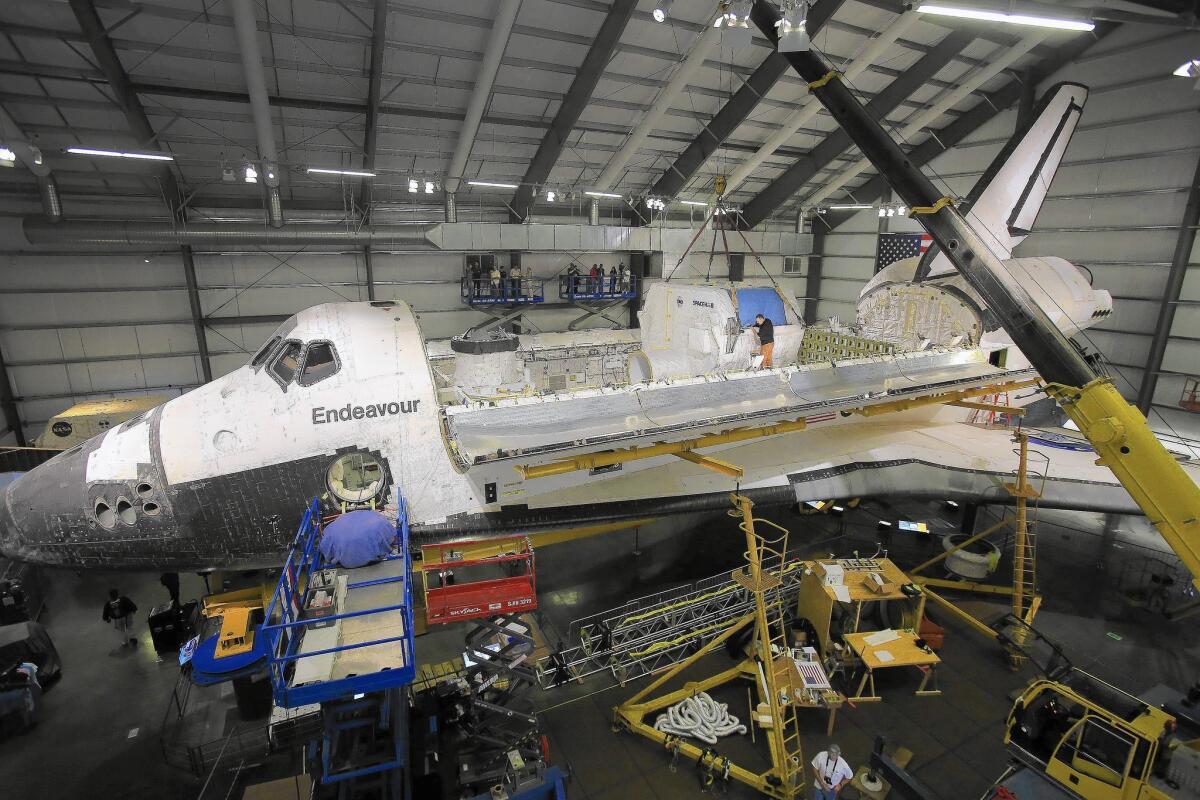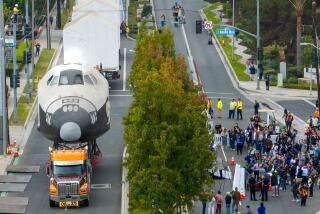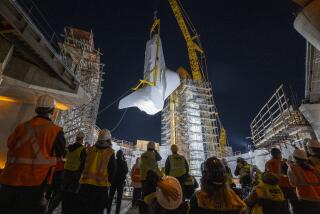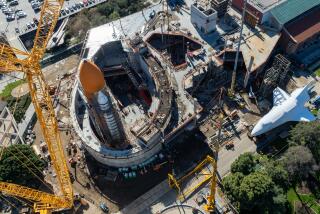Space shuttle Endeavour inches closer to completion of final exhibit

As if they were performing delicate surgery, a crew inside the California Science Center museum hoisted a 3,000-pound portable space lab and storage pod inside the space shuttle Endeavour’s huge cargo bay Thursday, reuniting the retired orbiter with a piece of equipment it used on some missions over its two decades of flight.
It was just one small step that, along with the installation of a replica robotic arm, airlock and docking system, moves the last shuttle ever built closer to becoming the nation’s most complete iteration of the grounded aircraft on exhibit.
None of the other shuttles on display have equipment in the cargo bay. Endeavour’s final pose will also be unique: It will be the only one of the three retired shuttles that orbited the Earth —Endeavour, Atlantis and Discovery — to be posed with its nose pointing to the stars, just like when it flew into space.
The final exhibit is still four years away from being complete. But the installation of equipment, which will continue in the coming days at the temporary exhibit site, will offer the public a rare, brief chance to see Endeavour with both cargo bay doors open before they are closed after Oct. 21.
The cargo bay is so enormous a school bus can fit in it — a scale most people have not been able to appreciate because the cargo bay doors were almost always closed when in public view on Earth. At its technologically awesome heart, the shuttle was a workhorse.
“That’s what this thing is about — bringing stuff to and from space,” said California Science Center president Jeffrey Rudolph. “So that’s why we really wanted to be able install a payload and put it up, and let people understand the function of the space shuttle a lot better.”
When the final exhibit at the yet-to-be built Samuel Oschin Air and Space Center is unveiled, visitors will get to see two views of the shuttle.
The plan is for people to first watch a movie about Endeavour before the screen rises, allowing guests to see the shuttle vertically.
“Just like it’s ready to launch,” Rudolph said. Walking to the other side, people will be able to peek inside the craft.
“That payload bay door will be open, and you’ll be able to look inside,” he said, and get a view of the laboratory and storage pod, named Spacehab. Visitors will be able to walk underneath the massive engines.
Spacehab was actually designed by the late aerospace entrepreneur Robert A. Citron as a way for tourists to go into space aboard the shuttles while remaining in the cargo bay, which was not airtight and had no oxygen when in space. NASA ended up never allowing tourists to travel on the shuttle for safety reasons. But the space agency recognized that the portable units could create more space inside the shuttle for astronauts to work.
Spacehab modules flew on the shuttles in 18 of 135 flights, including four on Endeavour. Only three Spacehab modules were made; one was on the space shuttle Columbia when it broke apart in 2003, and the other is on display on the floor of the California Science Center.
The addition of the portable lab into the shuttle was tricky because the cargo bay doors were only designed to open in the weightlessness of space, not when the vehicle is earthbound.
When the cargo doors were opened terrestrially, it was almost always done with special equipment at the Kennedy Space Center in Florida. The only other time that happened outside of Florida was in 1985, when the doors of the test orbiter Enterprise were opened in the Mojave Desert.
The next big steps for the Endeavour exhibit will probably happen next year, when construction of the $250-million Samuel Oschin Air and Space Center — its eventual home — begins.
The museum has so far raised about $100 million of the $250 million needed to complete it. It is expected to open in 2018.
The only other orbiter with at least one of its cargo bay doors open is Atlantis at the Kennedy Space Center. But unlike Endeavour, that shuttle’s cargo bay is empty.
[email protected]
Twitter: @ronlin
More to Read
Sign up for Essential California
The most important California stories and recommendations in your inbox every morning.
You may occasionally receive promotional content from the Los Angeles Times.











